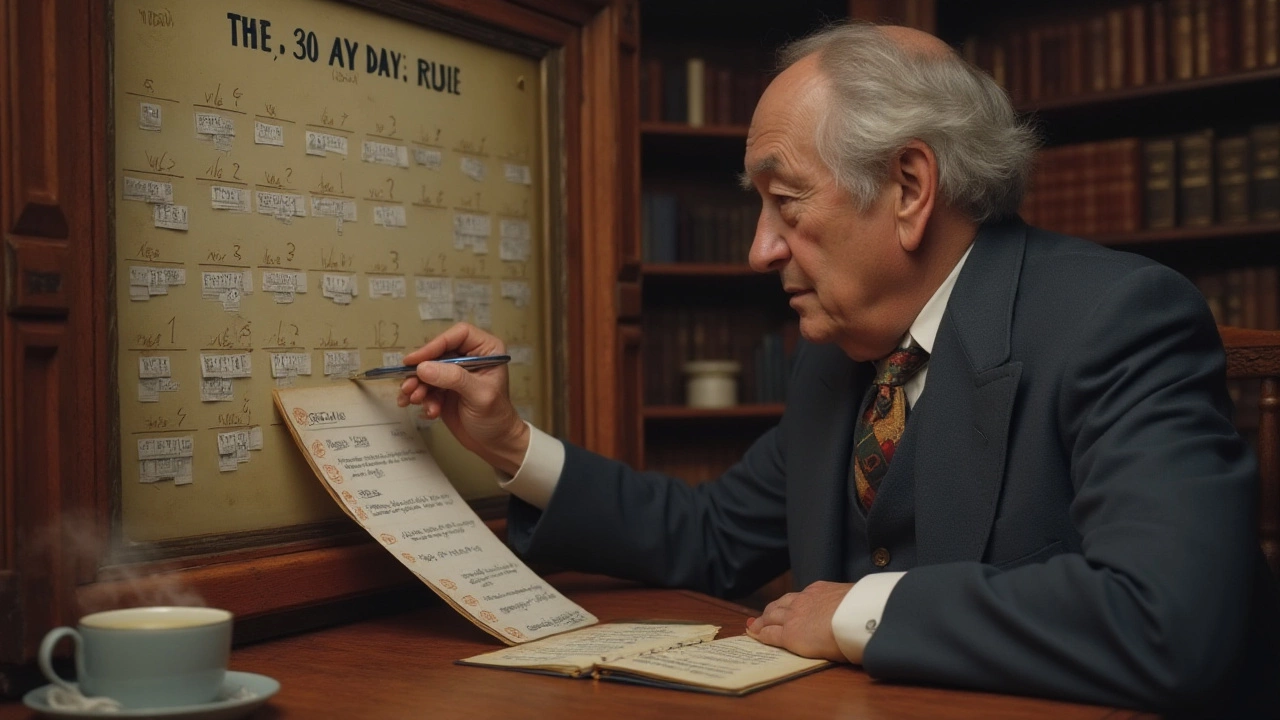Have you ever felt the lingering regret of buying something on a whim that you didn't truly need? The 30-day rule might be just the strategy for you. It's a simple yet effective method to control impulsive spending and enhance your savings efforts.
By pausing on a purchase for 30 days, you give yourself time to reflect on whether or not you really need the item. This habit often leads not only to better spending decisions but also to a greater sense of financial freedom. Whether you're saving for a dream vacation or just trying to get a handle on your monthly expenses, the 30-day rule can be a game changer.
- Understanding the 30-Day Rule
- Benefits of the 30-Day Rule
- Steps to Implement the 30-Day Rule
- Common Pitfalls and How to Avoid Them
- Success Stories and Real-Life Applications
Understanding the 30-Day Rule
At its core, the 30-day rule is a powerful tool that is all about delaying purchases to avoid impulse buying. This technique is simple: instead of buying an item immediately, you wait for 30 days and then revisit your decision. This waiting period allows for a cooling-off phase where the instant gratification dissipates, and the rationale for buying becomes the center of attention. It's akin to giving your mind a financial timeout, which is often what is needed to save from unnecessary expenditures.
This rule taps into the psychology of consumers and takes advantage of the way humans process decisions. According to financial experts, waiting helps evaluate necessity, affordability, and emotional triggers tied to spending. These considerations are often overlooked in the heat of the moment, particularly during sales or modes of stress. Consumers are bombarded with ads suggesting quick purchases are beneficial, yet, the 30-day rule suggests otherwise. Implementing this technique requires acknowledgment that our first desire to purchase may not be the most economic or sustainable decision. The rule has been embraced by many as a behavioral economic strategy that supports money management and resourcefulness.
It’s interesting to note that studies show that impulse purchases can make up around 40% of a person’s overall shopping budget. Imagine half of those expenses being redirected towards a more meaningful financial goal, like a vacation or a retirement fund. This realization alone has spurred individuals and even communities to adopt more disciplined buying habits. Indeed, the 30-day rule doesn't only apply to expensive or large items but can also be effective for smaller, frequent purchases leading to budget leaks. As we know, if you want to save up, the priority must be balancing the small costs.
"The 30-day rule is not just about savings; it's a way to recalibrate the mind’s relationship with money," said financial advisor Ben Tisdell in an interview with MoneyWise.Using this strategy requires understanding its flexibility; it is not about deprivation, but prioritization. To see the best results with the 30-day rule, one should keep a list of desired items and mark the date when the decision can be reconsidered. A journal or budgeting app can serve this purpose very well. Monitoring not only time but your evolving thoughts about the purchase can be eye-opening. As the days pass, many find that items on their list lose appeal or are replaced by more meaningful choices. This shift indicates how strategic patience can transform into a pathway for financial planning and savings without the stress of rigid budgeting plans.
Benefits of the 30-Day Rule
The 30-day rule isn't just a strategy; it's a mindset shift that can lead to more deliberate spending and heightened financial awareness. One of the biggest advantages is the ability to make more informed spending decisions. When you pause on making a purchase, you give yourself the time to determine if the purchase aligns with your needs and goals. This pause helps in filtering out emotions that might have clouded your judgment initially, like the excitement of seeing something new or the pressure from a flash sale.
Adopting the 30-day rule also leads to increased savings, as it cuts down on unplanned expenses. When you delay a potential purchase, you often find that the urge to buy diminishes over time. Instead of succumbing to impulsive purchases, you begin to prioritize what truly matters to you, directing your resources to meaningful expenses or savings. According to a study by the CFPB, people who implemented similar delay tactics found that they were able to save up to 20% more monthly by avoiding non-essential purchases.
"Taking a conscious pause before spending can be transformative. Seeing it less as a restriction and more as a moment of reflection can open up new financial opportunities," said financial advisor Sarah Collins during a recent interview with Money Matters magazine.
Another major benefit of the 30-day rule is its positive impact on reducing buyer's remorse. By honing your judgment through this strategy, you experience fewer regrets over purchases. It builds a stronger relationship between your desires and your long-term financial objectives. This strategy ties closely to mental well-being, as knowing you’re in control of your financial outcomes naturally reduces stress and anxiety related to money.
Beyond personal finance, the 30-day rule encourages a more sustainable lifestyle. By doubling down on the purchases you actually need, you become more conscious of consumption and contribute less to waste — a valuable contribution to environmental conservation. With the rise of eco-consciousness, adopting budgeting tips like the 30-day rule helps in fostering sustainability without taking drastic measures.
Notably, the flexibility of the 30-day rule works across all budgets and incomes. Whether you’re saving on a modest salary or managing a larger budget, this straightforward method adapitates all. It’s a testament to how simple resource management strategies can quickly translate into substantial benefits. In fact, a survey conducted by the National Financial Educators Council showed that 72% of participants felt more empowered about their financial decisions after applying the 30-day rule for three months.

Steps to Implement the 30-Day Rule
Implementing the 30-day rule is a straightforward process that can fundamentally alter how you perceive spending. The first step in using this strategy is recognizing a purchase impulse. This might seem easy, but in a world filled with tempting deals and advertisements, distinguishing between a want and a need can be tricky. It starts with a pause. When you feel the urge to buy, instead of acting on it immediately, take a moment to evaluate its necessity. This deliberate pause is key to mastering this budgeting tip effectively.
After recognizing the impulse, jot down the item you want to purchase, along with its cost and the reason for your interest. This act of writing things down serves a dual purpose. It not only keeps track of your impulses but also forces you to articulate the reason behind the desire. Pairing this with your broader financial goals—such as saving for a major purchase or building an emergency fund—can provide additional motivation to adhere to the 30-day rule.
Now comes the wait. Set aside your notes and commit to the 30-day wait period. During these days, remind yourself of your financial goals whenever you feel tempted. This might seem challenging initially, especially if you're accustomed to buying on whims, but with practice, it will become second nature. It can be surprisingly satisfying to see how many of those early impulses wane over time, leaving you with a sense of control over your spending. In the words of financial expert Suze Orman, "A big part of financial freedom is having your heart and mind free from worry about the what-ifs of life."
After the 30 days have passed, revisit the item on your list and reassess your desire. Do you still want it? Is it as important to you now as it seemed initially? Can you buy it without derailing your financial plans? These questions will help you decide if the purchase aligns with your current financial situation and goals. Interestingly, studies have shown that people who adhere to structured spending plans often report feeling more satisfied with their purchases.
To make this rule even more effective, involve accountability partners like family or friends in your journey. Sharing your list with someone you trust can provide an additional layer of support and accountability. You might be surprised at the insights others can offer, helping you view your spending habits from a different perspective. This external input, combined with your personal reflection, will forge a robust defense against unnecessary spending and promote healthier financial habits.
An alternative approach, if you're tech-savvy, is to use budgeting apps that allow you to digitally note and track your impulse items. Some apps provide reminders and evaluations of your financial health, which can be beneficial in maintaining your commitment to the rule. This technological assistance, alongside traditional pen-and-paper methods, can support a more dynamic and adjustable financial strategy, making it easier to stick to your money management goals in the long term.
Common Pitfalls and How to Avoid Them
Even the best strategies come with their own set of challenges, and the 30-day rule is no exception. One of the most common pitfalls is the urge to abandon the rule during sales or promotional events, which are designed to provoke instant buying decisions. When those tempting tags reel us in with promises of massive savings, it can be incredibly hard to stick to your guns, but remember: no purchase results in more savings than any discount can offer. To counteract this, try unsubscribing from store newsletters or apps that entice you with deals. This simple step can help reduce temptation and keep you committed to your financial journey.
Another trap is the belief that all your purchases should be put on hold, which can lead to decision paralysis. When everything is delayed, you might find it challenging to differentiate between wants and needs, causing frustration and overthinking on every transaction. It's crucial to strike a balance; apply the rule to discretionary purchases rather than necessities. Creating a clear list of needs versus wants at the outset can provide a roadmap and prevent indecision down the line. An interesting psychological trick to distinguish your wants from needs is to visualize the absence of the item. Ask how it would affect your daily life if you opted not to get it. Such reflective techniques are valuable in showcasing the role of your purchase decisions in daily existence.
Another habitual roadblock is substituting the delay with smaller, yet frequent purchases as a way to satisfy an urge, thinking you are still saving in a way. The sporadic $10 or $20 expenses add up quicker than you might realize, eroding any potential benefits the money management rule offers. Awareness is key; a thorough review of all small expenditures can often reveal a surprising total over the month. Tracking apps or old-fashioned journaling can be tremendously helpful in this regard. They provide a visual representation of your habits that can serve as a wake-up call. To maintain the budget lane, you can also set a weekly check-in with yourself.
One might question whether such a disciplined approach stifles spontaneity or enjoyment, inadvertently leading to guilt-associated spending after the wait is over. To avoid negative associations, consider framing your 30-day waiting period positively. Use it as a beneficial tool for adopting a healthier relationship with shopping rather than as a restrictive measure. You reserve the right to reward yourself thoughtfully. A quote worth pondering comes from financial coach, Dave Ramsey, who beautifully put it:
'Children do what feels good. Adults devise a plan and follow it.'
Finally, it's worth noting that life's unpredictability can throw a wrench in your intentions. Sometimes, urgent needs emerge unexpectedly, demanding immediate finances whether you're ready or not. While sticking to the 30-day rule during those times seems improbable, it's an opportunity to revisit your financial structure. Emergency funds play a pivotal role, offering a solution for such sudden emergencies without detracting from your savings strategy. By cushioning these financial blows with a structured safety net, you bring equilibrium back to your money management, keeping long-term goals from being derailed by short-term crises.

Success Stories and Real-Life Applications
Throughout the years, the 30-day rule has become a beacon of hope for countless individuals seeking to revolutionize their approach to money management. This powerful strategy has found its place not only in personal anecdotes but also in structured financial advice published by experts in the field. The beauty of this method is its simplicity; it's a practice that requires nothing more than patience and a willingness to reconsider one's impulses. It's not uncommon to hear people exchanging tales of triumph where the 30-day rule helped turn their chaotic finances into a story of success.
One remarkable story is that of Emma, a young professional who embarked on a journey to curb her shopping habits in an effort to save for a much-desired home. She found herself often drawn to trendy clothing stores, succumbing to the enticing allure of sales and limited-time offers. Realizing the impact of her spending sprees on her long-term dream, Emma adopted the 30-day rule. Each time she felt the urge to splurge, she noted the item in her journal and revisited the desire after 30 days. To her surprise, she found that many of the items she initially wanted no longer appealed to her. This gradual shift in perspective significantly bolstered her savings account, allowing her to invest in a house within two years, proving that small changes can indeed yield significant results.
The influence of the 30-day rule reaches beyond individual scenarios. Financial consultants have embraced it as a core element of their recommendations. The premise is simple: delay gratification to assess the true necessity of a purchase. By doing so, consumers can avoid the buyer's regret that often accompanies impulsive decisions. In fact, a survey conducted by a leading financial advisory group revealed that money management practices that included the 30-day rule reduced unnecessary spending by an average of 20% per annum for their clients. These findings underscore the rule's effectiveness as a tool for both savings strategy and financial planning.
An interesting real-world application was highlighted in a
The New York Times article emphasizing financial responsibility: "Those who adopt the 30-day rule frequently find themselves questioning not just what they buy, but why they buy. This newfound awareness often leads to deeper, more meaningful financial habits." The 30-day rule doesn't merely curb spending; it transforms the way individuals engage in monetary decisions, fostering sustainable change.For success with the 30-day rule, it's helpful to document potential purchases and reflect on them thoroughly. An example of this practice is maintaining a dedicated wish list or spreadsheet, which can serve as a visual reminder of one's financial priorities. By listing each item along with its cost and potential value, users can easily revisit their purchasing intentions with a clear mind. Over time, this simple habit becomes second nature, enabling individuals to integrate thoughtful decision-making seamlessly into their everyday lives.
The charm of the 30-day rule lies in its adaptability and accessibility. People from various walks of life have found it to be a great companion in achieving their goals. Whether it's a student saving for a backpacking trip across Europe or a retiree seeking to optimize retirement funds, the 30-day principle presents a universal solution. The key takeaway is the empowerment bestowed upon users to reclaim control of their financial destiny, all by a simple pause and reflection.
